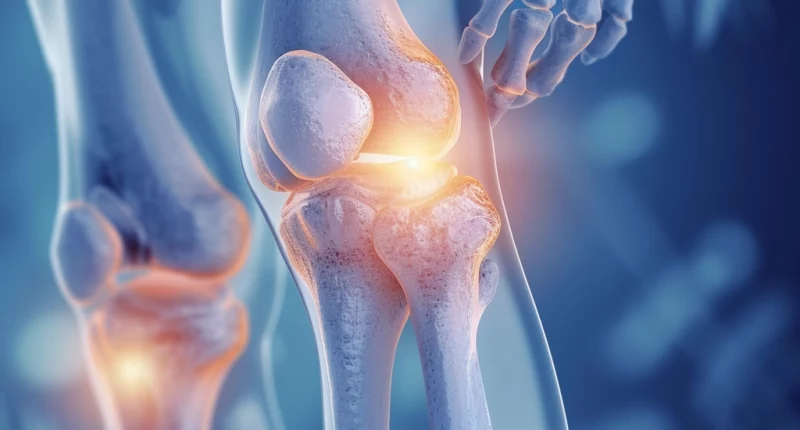Baker’s cyst
What is a Baker’s cyst?
Baker’s cyst is a fluid-filled formation in the popliteal fossa connected to the knee joint by a valve. A synovial cyst of the knee joint is always localized in the muscle layer of the popliteal area (between the semitendinosus and calf muscles).
About the disease
The disease is based on a valve mechanism involving fluid infiltration from the joint into the cyst, with no return flow of effusion possible. Unidirectional fluid flow is believed to be associated with compression of the opening by the cyst itself, tendon bundles of muscles, and the duplication of the joint capsule, which acts as a flap.
Baker’s cyst can resolve independently, but often has an acute course. At the same time, with the development of persistent inflammation of the synovial membrane, the disease is transformed into a chronic form. Partial absorption of the effusion creates conditions for thickening, which subsequently makes it impossible to evacuate the fluid fully. The prolonged existence of cystic formation can form connective tissue traction and cyst removal.
One of the dangerous consequences of the cyst, which is associated with the rapid flow of effusion, is the rupture of the synovial hernia. In this case, synovial fluid spreads between the fasciae of the leg, covering the muscle layers. When the synovial cyst ruptures, there are vivid clinical signs of the disease – swelling of the leg and intense pain.
Diagnosis of Baker’s cyst is based on the results of ultrasound scanning. Computed tomography (CT) or magnetic resonance imaging (MRI) is performed in complex clinical cases.
Baker’s cyst surgery is a radical method of surgical treatment. It is aimed at stopping the unidirectional flow of synovial fluid.
Symptoms of Baker’s cyst
Let’s look at a Baker’s cyst from a clinical point of view. Most often, this condition is asymptomatic in the absence of complications. If the cyst is medium or large, it becomes visible on examination and accessible for palpation. The cyst is defined as a longitudinal-oval mass of dense elastic consistency in the inner parts of the popliteal region.
Large cysts limit flexion in the knee joint. At this stage, the person has discomfort and pain in the posterior part of the knee, which increases with exercise. Sometimes, the clinical manifestations of the disease are characterized by pain in the calves and impaired sensory innervation of the posterior part of the lower leg, and these symptoms of Baker’s cysts become especially pronounced after prolonged walking or stair climbing.
Causes of Baker’s cysts
A popliteal cyst is often a secondary pathology that develops in response to prolonged irritation of the joint’s synovium in a particular disease. The causes of Baker’s cyst are trauma to the knee and reactive inflammation of the synovial membrane that develops in osteoarthritis, rheumatoid arthritis, etc.
Diagnosis of Baker’s cyst
The primary method on which the diagnostic search for hamstring cysts is based is ultrasound scanning. Ultrasound helps visualize the pathological formation, determine its size and boundaries, and the relationship with the surrounding structures of the joint and paraarticular area. Ultrasound helps in diagnosing complications of the disease – rupture or suppuration.
The main echographic signs of the disease are:
- Location in the popliteal fossa, just inside the popliteal artery and vein (the latter running in the central part of the fossa);
- The presence of an avulsion connecting the cyst to the knee joint;
- A rounded-shaped mass that is somewhat elongated in length or crescent-shaped.
In complex clinical cases, magnetic resonance imaging (MRI) is indicated. Radiography is performed to exclude concomitant bone pathology.
Baker’s cyst treatment
Baker’s cysts can be treated using different methods, which consider the peculiarities of the course of the disease.
Conservative treatment
Application of drugs to the cyst and taking non-steroidal anti-inflammatory drugs do not bring the desired therapeutic result. Therefore, conservative therapy of the cyst is considered to be an ineffective approach.
Evacuation of fluid from the cyst is often accompanied by recurrence of the disease. Therefore, it is pathogenetically justified to influence the synovial membrane, which produces fluid accumulated in the cystic formation. To achieve this goal, intra-articular administration of corticosteroids can be performed. However, evacuation of the fluid, a “thickened” synovial effusion, is completed beforehand.
In the case of a ruptured Baker’s cyst, anti-inflammatory therapy is also warranted against the intra-articular structures and the wall of the ruptured mass. The drugs are injected into the joint cavity.
Surgical treatment
If there is a recurrence shortly after puncture and evacuation of the synovial cyst, then according to clinical guidelines, surgical intervention is indicated, which is mainly performed arthroscopically. The surgery may involve one-stage laser cauterization of the opening that connects the cyst to the knee joint. Other surgical interventions are also possible:
- removal of part of the synovial membrane;
- repairing intra-articular injuries;
- cyst removal.
If technically arthroscopy is ineffective and if the cyst is significant, open surgery with the application of fascia duplicature to the area of the slit-shaped joint can be performed.
All these surgical procedures are performed in more than 790 hospitals worldwide (https://doctor.global/results/diseases/bakers-cyst). For example, Baker’s cyst surgery can be done in 43 clinics across Germany for approximate price of $7.2 K (https://doctor.global/results/europe/germany/all-cities/all-specializations/procedures/bakers-cyst-surgery).
Complications
While Baker’s cysts are generally benign, complications can arise, such as:
- Burst cysts, leading to pain and swelling
- Compression of blood vessels or nerves
Baker’s cyst prevention
The main areas of prevention of Baker’s cyst are:
- Prevention of knee joint injuries;
- Timely treatment of primary conditions that may increase the risk of popliteal hernia (particularly arthritis, osteoarthritis, synovitis).
- Regular exercise to strengthen knee muscles
- Maintaining a healthy weight to reduce knee stress
Rehabilitation after Baker’s cyst
Rehabilitation after surgically treating Baker’s cyst involves improving the functionality of the knee joint. Therapeutic exercise, massage, physiotherapy, and knee taping are successful for this purpose.
Conclusion
Baker’s cyst is a common knee problem, especially among those with underlying knee conditions. While they can cause discomfort and mobility issues, most cysts are manageable with conservative treatments. Understanding the causes and treatment options is crucial for those affected, and long-term management of knee health plays a key role in prevention. It’s important for individuals experiencing symptoms of a Baker’s cyst to seek medical advice for proper diagnosis and treatment.


